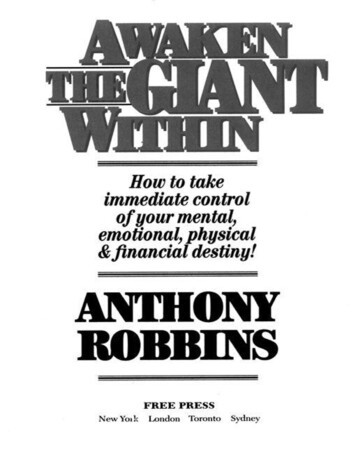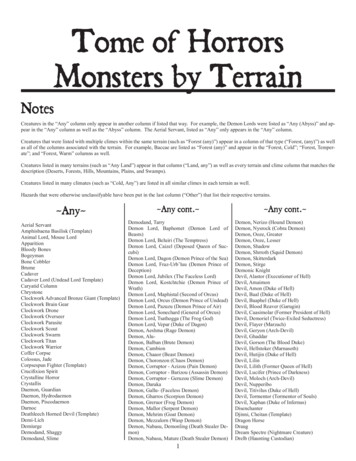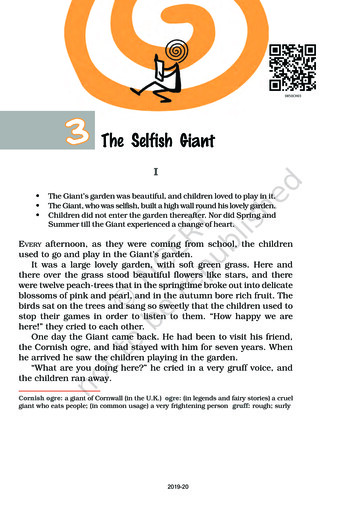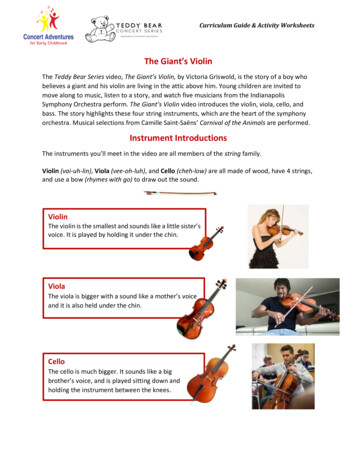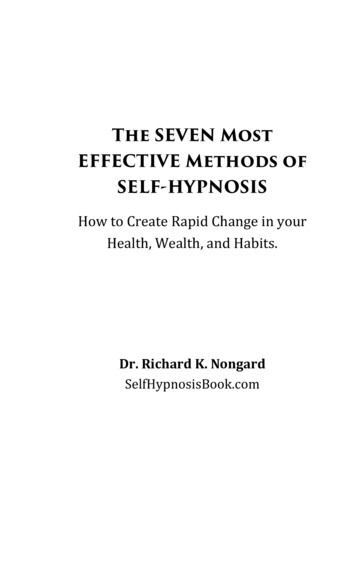
Transcription
Book SummaryAwaken The Giant Within(Anthony Robbins)DISCLAIMERAll credit goes to Anthony Robbins and his book Awaken The Giant Within. All copyrights andtrademarks are property of their respective owners. Our goal is only to promote the amazing booksthat Anthony Robbins has created. Please buy the full book below:http://amzn.to/1z4Yjq01Book Summary Written by Greg Henriques
ContentsDreams of destiny . 3!Decisions: the pathway to Power . 4!The force that shapes our life . 5!Belief systems: the power to create and the power to destroy . 6!Can change happen in an instant? . 7!How to change anything in your life: The science of Neuro-Associative Conditioning . 8!How to get what you really want . 9!Questions are the answer . 10!The vocabulary of ultimate success . 11!The power of life metaphors . 11!The 10 emotions of power . 12!6 steps to Emotional Mastery . 13!The 10 Action Signals . 14!The 10 emotions of power . 15!The magnificent obsession – creating a compelling future . 15!The 10 day mental challenge . 16!Ultimate influence: the master system . 18!Life Values: your personal compass . 19!References: the fabric of life . 19!Identity: the key to expansion . 21!The seven days to shape your life . 22!Day 1: Emotional destiny - the only true success. 22!Day 2: Physical Destiny – Prison of pain or palace of pleasure . 22!Day 3: relationship destiny – the place to share and care. 24!Day 4: financial destiny – small steps to a small (or large) fortune . 24!Day 5: Be impeccable: your code of conduct . 25!Day 6: Master your time and your life. 25!Day 7: Rest and Play - even God took one day off! . 26!2Book Summary Written by Greg Henriques
Dreams of destinyMost people have no idea of the giant capacity we can immediately command when we focus allof our resources on mastering a single area of our lives.For changes to be of any true value, they’ve got to be lasting and consistent:Step1: raise your standardsStep 2: change your limiting beliefs. Our beliefs are like unquestioned commands, telling us howthings are, what’s possible and what’s impossible, what we can or can not do. They shape everyaction, every thought, and every feeling that we experience. We must develop a sense of certaintythat we can and will meet new standards before we actually do.Step 3: change your strategy. In order to keep your commitment, you need the best strategies forachieving results.In life, lots of people know what to do, but few people actually do what they know. Knowing is notenough! You must take action.The 5 areas that impact us most:1. Emotional Mastery: every thing we do is to change the way we feel2. Physical Mastery: health, feeling powerful and energized will make you feel in control ofyour life3. Relationships Mastery: the greatest resource you need is relationships because it opensthe doors to every other resource you need.4. Financial Mastery: to forge a financial destiny of abundance, learn first how to change whatcauses scarcity in your life, and then how to experience on a consistent basis the values,beliefs, and emotions that are essential to experiencing wealth and holding on to it andexpanding it5. Time Mastery: this is not about time management, it is more about allowing your ideas, yourcreations, even your own potential, the time to reach full fruition. People overestimate whatthey can accomplish in a year, and underestimate what they can accomplish in a decade.!3Book Summary Written by Greg Henriques
Decisions: the pathway to PowerHow am I going to live today in order to create the tomorrow I’m committed to? What am I going tostand for from now on?In essence, if we want to direct our lives, we must take control of our consistent actions. It’s notwhat we do once in a while that shapes our lives, but what we do consistently. Decisions precedeactions. It is in the moments of your decisions that you shape your destiny.Decide who and what you are committed to having and being in your life. This is much more thansomething you would “like”, this is a must, a solid commitment.If you don’t set a baseline standardfor what you’ll accept in your life, you’ll find it’s easy to slip into behaviors and attitudes or a qualityof life that’s far below what you deserve.You must know that you can make a new decision right now that will immediately change your life– a decision about a habit you’ll change or a skill that you’ll master, or how you’ll treat people.Your life changes the moment you make a new, congruent, and committed decision. Making a truedecision means committing to achieving a result, and then cutting yourself off from any otherpossibility.Realize that decision making, like any skill you focus on improving, gets better the more often youdo it. The more often you make decisions, the more you’ll realize that you truly are in control ofyour life.The 3 decisions that control your destiny are: Your decisions about what to focus onYour decisions about what things mean to youYour decisions about what to do to create the results you desireYour brain has constructed an internal system for making decisions, which is comprised of fivecomponents:1.2.3.4.5.Your core beliefs and unconscious rulesYour life valuesYour referencesYour habitual questionsYour emotional statesThe scary thing is that most people never consciously set this system up. Instead, it’s beeninstalled through the years by sources as diverse as parents, peers, teachers, television,advertisers and the culture at large.4Book Summary Written by Greg Henriques
The good news is that we can override this system by making conscious decisions at any momentin our lives.The final impediment to really utilizing the power of decision is that we must overcome our fears ofmaking the wrong decisions. You’re going to screw up! You must commit to learning from yourmistakes rather than beating yourself up, or you’re destined to make the same mistakes again inthe future.“Life is either a daring adventure or nothing”.The force that shapes our lifeEvery thing we do is either out of our need to avoid pain or our desire to gain pleasure.What prevents you from changing? The answer is simple. Even though you know that all theseactions would benefit you – that they could definitely bring pleasure to your life – you fail to actsimply because in that moment you associate more pain to doing what’s necessary than missingthe opportunity.Why is it that people can experience pain yet fail to change? They haven’t experienced enoughpain yet; they haven’t hit the “emotional threshold”.What you link pain to, and what you link pleasure to shapes your destiny.What are some of the experiences of pain and pleasure that have shaped your life?If we link massive pain to any behaviour or emotional pattern, we will avoid indulging in it at allcosts. We can use this understanding to harness the force of pain and pleasure to change virtuallyanything in our lives.Although we’d like to believe it’s our intellect that really drives us, in most cases our emotions –the sensations that we link to our thoughts – are what truly drive us. We have built neuroassociations in our nervous system to define the experiences that bring us pain or pleasure. Manytimes we try to override the system, but in order for the change the last, we must link pain to ourold behaviour and pleasure to our new behaviour.The truth is that we can learn to condition our minds, bodies and emotions to link pain or pleasureto whatever we choose. By changing what we link pain and pleasure to, we will instantly changeour behaviors.The problem is that most of us base our decisions about what to do on what’s going to create painor pleasure in the short term instead of the long term.Most of the things that are valuable in our lives require us to go against the basic conditioning ofour nervous system and be willing to overcome our fear of rejection and vulnerability.5Book Summary Written by Greg Henriques
Belief systems: the power to create and thepower to destroyIt’s never the environment, it’s never the events of our lives, but the meaning we attach to theevents – how we interpret them – that shapes who we are today and who we’ll become tomorrow.What are our beliefs designed for? They’re the guiding force to tell us what will lead to pain andwhat will lead to pleasure. Our beliefs are driven by our generalizations about what we’ve learnedcould lead to pain and pleasure. These generalizations guide all of our actions and thus thedirection and quality of our lives.Generalizations can be very useful, as they simplify our lives and allow us to function providingenough references to create a sense of certainty that allows us to follow through. In more complexareas of our lives, generalizations can oversimplify and sometimes create limiting beliefs.We need to remember that most of our beliefs are generalizations about our past, based on ourinterpretations of painful and pleasurable experiences. The challenge is threefold:1. Most of us do not consciously decide what we’re going to believe2. Often our beliefs are based on misinterpretation of past experiences3. Once we adopt a belief, we forget it’s merely an interpretationIf you want to create long-term and consistent changes in your behaviors, you must change thebeliefs that are holding you back.What is a belief? It is a feeling of certainty about something supporting by a number of referencesto support the idea. With enough emotional intensity and repetition, our nervous systemsexperience something as real, even if it hasn’t occurred yet. So the question is not which of yourbeliefs is true, the question is which belief is most empowering.If you’re going to make an error in life, err on the side of over-estimating your capabilities.One of the biggest challenges in anyone’s life is knowing how to interpret “failures”. We need toremember that how we deal with adversity and challenges will shape our lives more than almostanything else.So how to change a belief? The most effective way is to get your brain to associate massive painto the old belief. Then you must associate tremendous pleasure to the idea of adopting a new,empowering belief.6Book Summary Written by Greg Henriques
Can change happen in an instant?All changes are created in an instant, so why is it that most people think change takes so long?One reason, obviously, is that most people have tried time and time again through willpower tomake changes, and failed. The assumption that they then make is that important changes musttake a long time and be very difficult to make.In reality, it’s only difficult because most of us don’t know how to change! We don’t have aneffective strategy. Willpower in itself is not enough, not if we want to achieve lasting change.If we are going to succeed in creating long-term change, once we effect a change we shouldreinforce it immediately. Then, we have to condition our nervous systems to succeed not justonce, but consistently. You wouldn’t go to a fitness class just one time and say: “Okay, now I’vegot a great body and I’ll be healthy for life!” The same is true of your emotions and behaviour.The first belief we must have if we’re going to create change quickly is that we can change now.After all, if you are able to create a problem in a moment, you should be able to create a solutiontoo!The second belief that you and I must have if we’re going to create long-term change is that weare responsible for our own change, not anyone else.Long-term change requirements: Something must changeI must change itI can change itEach time we experience a significant amount of pain or pleasure, our brains search for the causeand record it in our nervous systems to enable us to make better decisions about what to do in thefuture.7Book Summary Written by Greg Henriques
How to change anything in your life: Thescience of Neuro-Associative Conditioning1. Decide what you really want and what’s preventing you from having it nowThis is about what you do want, so that you have something to move towards.2. Get leverage: associate massive pain to not changing now and massive pleasure tothe experience of changing now!The only way we’re going to make a change now is if we create a sense of urgency that’sso intense that we’re compelled to follow through. If you have tried to change and failed todo so, this simply means that the level of pain for failing to change is not intense enough.You have not reached threshold, the ultimate leverage. So why would someone not changewhen they feel and know that they should? They associate more pain to making the changethan to not changing. To get true leverage, ask yourself pain-inducing questions: “what willit cost me if I don’t change?” “Ultimately, what will I miss out on in my life if I don’t make theshift?” If it does not create enough leverage, then focus on how it affects your loved ones.The second step is to use pleasure-associating questions to help you link those positivesensations to the idea of changing.3. Interrupt the limiting patternHave you ever seen a fly that’s trapped in a room? It immediately searches for the light, soit heads for the window, smacking itself against the glass again and again, sometimes forhours. Have you ever noticed people do this? They’re highly motivated to change but all themotivation in the world won’t help if you try to get outside through a closed window. You’vegot to change your approach.4. Create a new, empowering alternativeThe failure by most people to find an alternative way of getting out of pain and into thefeelings of pleasure is the major reason most people’s attempts at change are onlytemporary.5. Condition the new patter until it’s consistentThe simplest way to condition something is simply to rehearse it again and again until aneurological way is created. If you imagine doing an empowering alternative with emotionalintensity it works too. Your brain won’t tell the difference between vividly imagining andsomething you actually experience. It is important to set up a schedule to reinforce yournew behaviour. How can you reward yourself for succeeding? Do it early, as soon as youtake action, reward yourself to link great pleasure to change. Any pattern of emotion orbehaviour that is continually reinforced will become an automatic and conditioned response.Anything we fail to reinforce will eventually dissipate. Reinforcement happens immediatelyafter it occurs.6. Test it!Make sure it is going to work in the future with some future pacing: imagining yourself in afuture situation using your change, and see how you feel. Also check the ecology of your8Book Summary Written by Greg Henriques
change: the consequences on you and on other around you, and the alignment with yourvalues.How to get what you really wantWhatever you want, at the root, you want it because you see it as a means to achieving a certainfeeling, emotion, or state that you desire.We can instantly change what we believe will lead to pain or pleasure by redirecting our focus andchanging our mental-emotional-physiological states.Emotion is created by motion. Everything that we feel is the result of how we use our bodies. Onceyou learn how you use your body when in certain emotional states, you can return to those states,or avoid them, simply by changing your physiology.The key to life is to make you feel good when you don’t, or even when you don’t want to feel good.Whatever we focus on becomes our idea of the reality. So focus on where you want to go, not onwhat you fear. So make sure you condition yourself to be positive and to direct your mind. How?The most powerful tool is to control focus is the use of questions. For whatever you ask, your brainprovides an answer; whatever you look for, you’ll find.You can use sub-modalities to change your state. The keys to live your life in a way that causesyou to feel tones of pleasure and very little pain are:1. To be able to change your state instantly2. To be able to change your state in any environment3. To establish a set of habitual patters of using your physiology and focus so that youconsistently feel good without any conscious effort whatsoeverDo you know how to make yourself feel good? The key is to create a huge list of ways to makeyourself feel good, and make you go from pain to pleasure. Then develop a plan for pleasure eachday and every day. Don’t just randomly hope that pleasure will somehow show up, set yourself upfor ecstasy!!9Book Summary Written by Greg Henriques
Questions are the answerThinking is nothing but the process of asking and answering questions. So if we want to changethe quality of our lives, we should change our habitual questions. These questions direct ourfocus, and therefore how we think and how we feel. Quality questions create a quality life.How do questions work?1. Questions immediately change what we’re focusing on and therefore how we feel2. Questions change what we delete. If you are really feeling sad, it’s because you’re deleting allthe reasons you could be feeling good, and vice versa. A good question for that is “What’sreally great in your life?” or “What’s great about this?” or “How can I learn from this so that thisnever happens again?”3. Questions change the resources available to us. A good question to ask in times of difficulty is“how can I turn this around?”The problem-solving questions:1. What is great about this problem?2. What is not perfect yet?3. What am I willing to do to make it the way I want it?4. What am I willing to no longer do in order to make it the way I want it?5. How can I enjoy the process while I do what is necessary to make it the way I want it?The morning power questions:1.2.3.4.5.6.7.What am I happy about in my life now?What am I excited about in my life now?What am I proud about in my life now?What am I grateful about in my life now?What am I enjoying most in my life right now?What am I committed to in my life right now?Who do I love? Who loves me?The evening power questions:1. What have I given today?2. What did I learn today?3. How has today added to the quality of my life?!10Book Summary Written by Greg Henriques
The vocabulary of ultimate successWith Words we not only create emotions, we create actions. And from our actions flows the resultsof our lives. If you want focus, all you need to do is ask the right questions, using the right words.The words you habitually choose also affect how you communicate with yourself and thereforewhat you experience.People with an impoverished vocabulary live an impoverished emotional life ; people with richvocabularies have a multihued palette of colors with which to paint their experience, not only forothers, but for themselves as well. Most people are not challenged, though, by the size of thevocabulary they consciously understand, but rather by the words they choose to use. Many times,we use words as shortcuts, but often these shortcuts change us emotionally.To consciously control our lives, we need to consciously evaluate and improve our consistentvocabulary to make sure that it is pulling us in the direction we desire instead of that which wewish to avoid.For example, if you develop a habit of saying you “hate” things – you “hate” your hair, you “hate”mornings, you “hate” your job, you “hate to do something” – do you think this raises the intensity ofyour negative emotional states more than if you were to use a phrase like “I prefer somethingelse”?The words we attach to our experience become our experience.Transformational Vocabulary can allow us to intensify or diminish any emotional state, positive ornegative. This means it gives us the power to take the most negative feelings in our lives andlower their intensity to the point where they no longer bother us, and take the most positiveexperiences and move them to even greater heights of pleasure and empowerment.You can also use modified like “just” or “a bit” or “slightly”The power of life metaphorsDestroy the blocks, break down the wall, let go of the rope, and dance your way to successIf you are feeling really bad about something, take a quick look at the metaphors you’re using todescribe how you are feeling, or why you are not progressing, or what is getting in the way. Oftenyou’re using a metaphor that intensifies your negative feelings.When people are experiencing difficulties, they frequently say things like “I feel like the weight ofthe world is on my back” or “there’s a wall in front of me, and I just can’t break through”. Butdisempowering metaphors can be changed just as quickly as they were created. If something can’tmake progress because they keep hitting a wall, they can just stop hitting it and drill a hole throughit, or climb over it or open the door and go through it.Anytime you use the words “I feel like” or “This is like” is often a trigger for the use of a metaphor.11Book Summary Written by Greg Henriques
Do you think that the metaphors you use in representing to yourself as well as to others what yourrelationship is like affect the way you feel about it and how you relate to one another? You bet!You may not feel passionate for a “partner”, but you certainly would for your “lover”.Stonecutter metaphor:When nothing seems to help, I go and look at the stonecutter hammering away at his rock,perhaps 100 times without so much as a crack showing in it. Yet at the 101st blow it will splitin two, and I know it was not that blow that did it, but all that had gone on before.Remember the stonecutter and keep hammering away!Limiting metaphors elicitation:1.2.3.4.5.What is life like?Make a list of all the metaphors you link to relationships or marriagePick another area of your life that impacts you mostCreate new, more empowering metaphors for each of these areasFinally, decide that you are going to live with these new, empowering metaphors for thenext thirty daysWrite these metaphors down and study their impact. Notice the positive and negativeconsequences of each of your metaphors. Exploring them can create new choices for your life.The 10 emotions of powerThere are 4 basic ways in which people deal with their emotions:1. Avoidance. We all want to avoid painful emotions. As a result, most people try to avoid anysituation that could lead to the emotions that they fear, or worse, some people try not to feelany emotions at all! Ultimately you can’t avoid feeling. A much more powerful approach is tolearn and find the hidden, positive meaning in those things you once thought were negativeemotions.2. Denial. People often try to disassociate from their feelings by saying, “it doesn’t feel thatbad”. Experiencing an emotion and trying to pretend it’s not there only creates more pain. Ifthe message your emotions are trying to deliver is ignored, the emotions simply increasetheir amperage; they intensify until you finally pay attention.3. Competition. Rather than learn the positive message their emotion is trying to give them,many people intensify it and make it even worse than it is. They begin to pride themselveson being worse off than anyone else. It then becomes a self-fulfilling prophecy where theperson ends up having an investment of feeling bad on a regular basis. A much morepowerful and healthy approach to dealing with the emotions that we think are painful is torealize that they serve a purpose.12Book Summary Written by Greg Henriques
4. Learning and Using. Emotions, even those that seem painful in the short term, are trulylike an internal compass that points you toward the actions you must take to arrive at yourgoals.The only way to effectively use your emotions is to understand that they all serve you. Theemotions that you once thought of as negative are merely a call to action. Rather thanemotions, you can call it Action Signals.Your past does not equal your future!We are always waiting for the right person or the right situation to come along before we feelgood. But who determines whether this is the right person or situation? When you do feel good,who’s making you feel good? You are! So why creating complex rules that allow you to feelgood? You don’t need any special reason to feel good, you can just decide to feel good rightnow, simply because you want to.What is the message of these Action Signals? They’re telling you that what you’re currentlydoing is not working, that the reason you have pain is either the way you’re perceiving things orthe procedures you’re using: specifically the way you’re communicating your needs anddesires to people, or the actions you’re taking.6!steps!to!Emotional!Mastery!These steps will help you to very quickly break your limiting patters, to find the benefit of yourpainful emotion, and to set yourself up so that in the future you can get the lesson from theemotion and eliminate the pain more quickly.STEP 1: Identify what you are really feelingSTEP 2: Acknowledge and appreciate your emotions, knowing they support youSTEP 3: Get curious about the Message this emotion is offering youSTEP 4: Get confident that you can handle this emotion immediatelySTEP 5: Get certain that you can handle this not only today, but in the future as wellSTEP 6: Get excited about handling this emotion, and take action!Remember, the best time to handle an emotion is when you first begin to feel it.!13Book Summary Written by Greg Henriques
The!10!Action!Signals!In order to prevent yourself from even having to use the 6 steps, you may find it useful to have aconscious understanding of what positive message each of your major emotions of action signalsis trying to give you.Action SignalDISCOMFORTFEARHurtAngerFrustrationThe messageBoredom, impatience, unease,distress, or mild embarrassmentare all sending you a messagethat something is not quite rightThe anticipation that somethingthat’s going to happen soonneeds to be prepared forWe have an expectation that hasnot been metAn important rule or standardthat you hold for your life hasbeen violatedYour brain believes you could bedoing better than you currentlyareDisappointmentAn expectation you have had isprobably not going to happenGuiltYou have violated one of yourown highest standards, and thatyou must do somethingimmediately to ensure thatyou’re not going to violate thatstandard again in the futureInadequacyYou don’t presently have a skillnecessary for the task at hand.It’s telling you that you needmore information, understanding,strategies, tools or confidenceOverload orOverwhelmYou need to re-evaluate what’smost important to you in thisThe solutionClarify what you wantRefine your actions and try a slightlydifferent approachEvaluate what you must do to prepareyourself mentally.Realize that in reality you may not have lostanything. Ask yourself how you might bejudging this situation too soon or too harshlyRealize that you may have misinterpretedthe situation completelyRealize that your rules may not be the rightrulesInterrupt the anger by asking yourself:“What can I learn from this?” How can Icommunicate the importance of thesestandards to this person?”Brainstorm new ways to get a resultFind a role modelGet fascinated by what you can learnImmediately figure out something you canlearn from this situation that could help youin the futureSet a new goal, something that will be evenmore inspiring and something you canmake immediate progress towardRealize that you may be judging too soon(God’s delays are not God’s denials)Acknowledge that you have violated acritical standard you hold for yourselfCommit yourself to making sure thisbehaviour will never happen again in thefutureAsk:
Awaken The Giant Within (Anthony Robbins) DISCLAIMER All credit goes to Anthony Robbins and his book Awaken The Giant Within. All copyrights and trademarks are property of their respective owners. Our goal is only to promote the amazing books that Anthony Robbins has created. Please buy the full book below:


